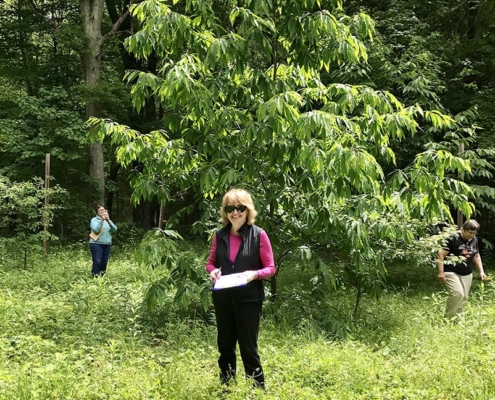The American Chestnut Begins Again
Since 2010, The Fairfield Garden Club has been a leader in New England in the national movement to return the lost American chestnut to our northeast forests. In April 2012, the club planted its first generation of 100 hybrid American chestnuts in eight public open spaces across the Town of Fairfield. Every year, in an annual review, the Club observes, tallies, and adds new seedlings where the sites have proven most propitious.
As of December 2018, we have 61 trees surviving. Thirty-nine of the original seedlings survive, some over 25 feet tall. Twenty two of 26 new seedlings added in 2016 are surviving. The newly planted trees are the sixteenth generations of hybridizing genetic material from the American chestnut with some material from the Chinese chestnut resistant to the blight. We will add 25 additional seedlings on selective sites in 2019.
Until the beginning of the 20th century, the American chestnut was one of the most important trees in the forests from Maine to Florida. Mature chestnuts averaged up to five feet in diameter and up to one hundred feet tall and grew at the astounding rate of 6 feet per year. Then the blight came. First discovered in 1904 in New York City, the blight, an Asian fungus to which our native chestnuts had very little resistance spread quickly, killing over 4 billion trees.
Recent developments in genetics and plant pathology promise that this magnificent tree will again become part of our natural heritage. In fact, “it will likely prove to be the greatest ecological comeback story of the century” (Yale School of Forestry Conference, 2006).
The Fairfield Garden Club has worked in an ongoing, three-way collaboration with our scientist partner and mentor, Dr. Sandra Anagnostakis, a plant pathology expert from the State of Connecticut’s Agricultural Station who has focused on chestnut blight since 1968 and the Town of Fairfield’s Conservation Department. The town offered The Fairfield Garden Club the land and the deer fencing, which has been pivotal in any survival. This remarkable project continues. In 2018, the first edible chestnuts have appeared.
This project offers four lessons: how and when to intervene with nature, identifying the greatest threats beyond blight, the knowledge that our success may not be evident in our lifetime and the recognition that the public may not directly witness this remarkable process.
Interventions with pesticides and fertilizers are not permitted. The sites are not in easily accessible public sites by intention to let nature take its course. The impact of invasives is devastating, and our project assumes that the town only mows once a year. These trees are subject to many natural pressures. Our biggest threats since 2012 have been several droughts, rampant invasives, young deer who get through the fences and ever-present woodchucks. Two of the eight sites have invasives where the young trees hardly can find sunlight.
However, The Fairfield Garden Club firmly believes this endeavor may become one of our greatest legacies. Not only is tree planting directly grounded in our over one-hundred-year history, but also the many growing American chestnuts cement our role as hopeful futurists and forest stewards. It is our gift to future generations.












